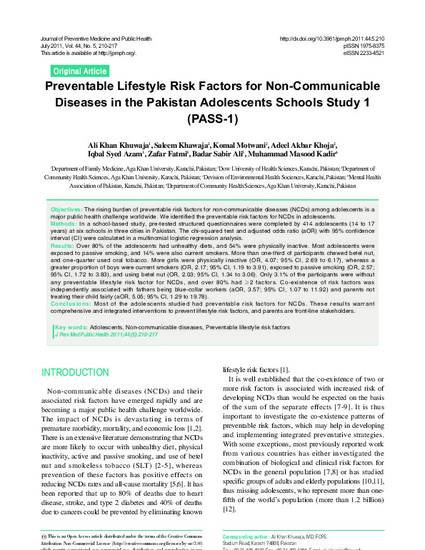
Objectives: The rising burden of preventable risk factors for non-communicable diseases (NCDs) among adolescents is a major public health challenge worldwide. We identified the preventable risk factors for NCDs in adolescents.
Methods: In a school-based study, pre-tested structured questionnaires were completed by 414 adolescents (14 to 17 years) at six schools in three cities in Pakistan. The chi-squared test and adjusted odds ratio (aOR) with 95% confidence interval (CI) were calculated in a multinomial logistic regression analysis.
Results: Over 80% of the adolescents had unhealthy diets, and 54% were physically inactive. Most adolescents were exposed to passive smoking, and 14% were also current smokers. More than one-third of participants chewed betel nut, and one-quarter used oral tobacco. More girls were physically inactive (OR, 4.07; 95% CI, 2.69 to 6.17), whereas a greater proportion of boys were current smokers (OR, 2.17; 95% CI, 1.19 to 3.91), exposed to passive smoking (OR, 2.57; 95% CI, 1.72 to 3.83), and using betel nut (OR, 2.03; 95% CI, 1.34 to 3.06). Only 3.1% of the participants were without any preventable lifestyle risk factor for NCDs, and over 80% had ≥2 factors. Co-existence of risk factors was independently associated with fathers being blue-collar workers (aOR, 3.57; 95% CI, 1.07 to 11.92) and parents not treating their child fairly (aOR, 5.05; 95% CI, 1.29 to 19.78).
Conclusions: Most of the adolescents studied had preventable risk factors for NCDs. These results warrant comprehensive and integrated interventions to prevent lifestyle risk factors, and parents are front-line stakeholders.
Available at: http://works.bepress.com/zafar_fatmi/61/
